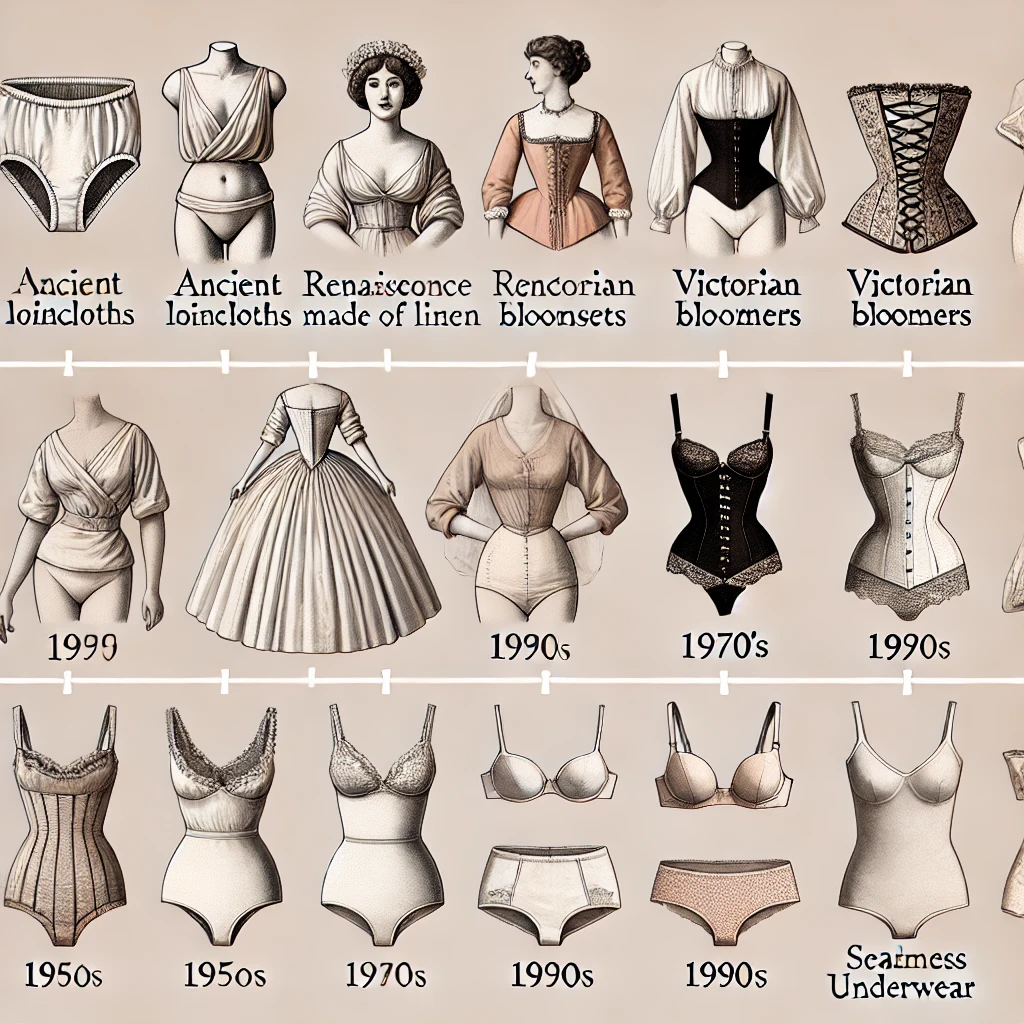The Evolution of Women’s Underwear: A Fashion Journey

Women’s underwear has undergone a dramatic transformation over the centuries, reflecting changes in fashion, societal norms, and technological advancements. From practical necessities to statements of style and empowerment, here’s a journey through the history and evolution of women’s underwear fashion.
1. Early Beginnings: Function Over Form
In ancient civilizations, underwear was rudimentary and functional.
• Egyptians and Romans: Women often wore loincloths or simple bands of cloth to cover their bodies. These early garments were practical, made from natural fibers like linen.
• Middle Ages: Women began wearing long chemises under their clothing. These were loose-fitting and served as a barrier between the skin and outer garments.
2. The Corset Era: Restriction Meets Refinement (16th-19th Century)
The Renaissance introduced corsets, marking a shift toward structured undergarments.
• Corsets were designed to shape the torso into an ideal silhouette, emphasizing a narrow waist.
• Though often beautiful with intricate lace and embroidery, they were restrictive and uncomfortable.
• By the Victorian era, undergarments expanded to include bloomers and crinolines, which added layers and volume to women’s attire.
3. The Birth of Modern Underwear: Freedom and Simplicity (20th Century)
The 20th century revolutionized women’s underwear with a focus on practicality and comfort.
• 1920s: Flapper fashion popularized lightweight chemises and step-ins, allowing freer movement.
• 1930s-1940s: The introduction of elastic fabrics led to bras, girdles, and panties becoming staples. Nylon revolutionized lingerie, making it affordable and accessible.
• 1950s: The post-war boom saw glamorous lingerie emerge. High-waisted briefs and cone-shaped bras became the epitome of femininity.
4. The Rise of Minimalism and Feminine Empowerment (1960s-1980s)
This era celebrated liberation and experimentation.
• 1960s: The women’s liberation movement rejected restrictive garments. Comfortable and minimal underwear gained popularity.
• 1970s: The rise of bikini briefs and seamless styles reflected the era’s laid-back ethos.
• 1980s: Lace and bold colors dominated, thanks to brands like Victoria’s Secret, which brought lingerie into the spotlight.
5. Contemporary Trends: Diversity and Inclusivity (1990s-Present)
Modern underwear fashion celebrates individuality and functionality.
• 1990s: The thong became iconic, thanks to its visibility under low-rise jeans. Brands like Calvin Klein made sporty underwear fashionable.
• 2000s: Seamless designs and microfiber fabrics catered to the demand for comfort in everyday wear.
• 2010s-Present: The industry has embraced body positivity, offering diverse sizes, skin-tone options, and styles for all preferences. Sustainable fabrics like bamboo and organic cotton are trending, reflecting eco-conscious values.
6. Future of Women’s Underwear: A Blend of Tech and Sustainability
• Smart Underwear: Innovations like moisture-wicking fabrics and temperature-regulating technology are on the rise.
• Sustainable Fashion: The focus on biodegradable materials and ethical production methods is shaping the future.
• Personalized Fit: Brands are leveraging technology to offer custom fits, ensuring maximum comfort for all body types.
Key Takeaways from Fashion’s Evolution
• Women’s underwear has transitioned from being purely functional to a mix of comfort, empowerment, and style.
• Every era reflects societal shifts, from the constriction of corsets to the liberation of minimalist designs.
• Today’s fashion prioritizes inclusivity, sustainability, and self-expression.
Underwear is no longer just an undergarment—it’s a reflection of personal style and societal values. The journey of women’s underwear is a testament to evolving fashion and cultural progress, celebrating freedom, diversity, and empowerment in every stitch.